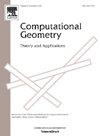On line-separable weighted unit-disk coverage and related problems
IF 0.4
4区 计算机科学
Q4 MATHEMATICS
Computational Geometry-Theory and Applications
Pub Date : 2025-03-18
DOI:10.1016/j.comgeo.2025.102188
引用次数: 0
Abstract
Given a set P of n points and a set S of n weighted disks in the plane, the disk coverage problem is to compute a subset of disks of smallest total weight such that the union of the disks in the subset covers all points of P. The problem is NP-hard. In this paper, we consider a line-separable unit-disk version of the problem where all disks have the same radius and their centers are separated from the points of P by a line ℓ. We present an time algorithm for the problem. This improves the previously best work of time. Our result leads to an algorithm of time for the halfplane coverage problem (i.e., using n weighted halfplanes to cover n points), an improvement over the previous time solution. If all halfplanes are lower ones, our algorithm runs in time, while the previous best algorithm takes time. Using duality, the hitting set problems under the same settings can be solved with similar time complexities.
关于线可分加权单位磁盘覆盖及相关问题
给定平面上一个包含n个点的集合P和一个包含n个加权磁盘的集合S,磁盘覆盖问题是计算总权重最小的磁盘子集,使得该子集中磁盘的并集覆盖了P的所有点。这个问题是np困难的。在本文中,我们考虑了该问题的一个可线可分的单位圆盘版本,其中所有的圆盘具有相同的半径,并且它们的中心与P点之间有一条线距离。我们提出了一个耗时O(n3/2log2 (n))的算法。这改进了之前O(n2log (n))时间的最佳工作。我们的结果导致了半平面覆盖问题(即使用n个加权半平面覆盖n个点)的O(n7/2log2 (n))时间算法,比之前的O(n4log (n))时间解决方案有所改进。如果所有半平面都是下半平面,我们的算法运行时间为O(n3/2log2),而之前的最佳算法运行时间为O(n2log)。利用对偶性,相同设置下的命中集问题可以用相似的时间复杂度来求解。
本文章由计算机程序翻译,如有差异,请以英文原文为准。
求助全文
约1分钟内获得全文
求助全文
来源期刊
CiteScore
1.60
自引率
16.70%
发文量
43
审稿时长
>12 weeks
期刊介绍:
Computational Geometry is a forum for research in theoretical and applied aspects of computational geometry. The journal publishes fundamental research in all areas of the subject, as well as disseminating information on the applications, techniques, and use of computational geometry. Computational Geometry publishes articles on the design and analysis of geometric algorithms. All aspects of computational geometry are covered, including the numerical, graph theoretical and combinatorial aspects. Also welcomed are computational geometry solutions to fundamental problems arising in computer graphics, pattern recognition, robotics, image processing, CAD-CAM, VLSI design and geographical information systems.
Computational Geometry features a special section containing open problems and concise reports on implementations of computational geometry tools.

 求助内容:
求助内容: 应助结果提醒方式:
应助结果提醒方式:


